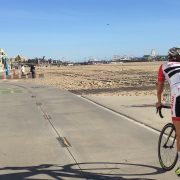Why a Powermeter? 5 Reasons Why Power Measurement is Useful to Cyclists
Power meters have become a lot more popular in recent years. What was once the domain of pros only, power measurement is now prevalent in all forms of racing and has trickled down into recreational cyclists as well.
Ask your fellow club cyclists where their sudden boost in strength came from, and you’re likely to head them tell you about their powermeter. But we’ll be first to admit—the powermeter itself doesn’t make you any faster. It’s all in how you use it. So why buy a powermeter?
1. Track and Measure your Power So You Don’t Tire Too Quickly
Whether it’s a race, a fondo or even just your weekly club ride, it can be easy to ride too hard, and end of having to limp home after the dreaded “bonk.” With a powermeter, you can be a lot more careful about the energy you expend, and have a better idea of what you’re capable of. Heart rate measurements work for this too, but with heart rate, there is lag. If you put in several sprints, for example, your heart rate might not even ride until after the effort is over. Watts are watts though, and sprints take a lot out of your legs. Only a powermeter can give you an accurate measure of just how much energy your ride is costing you.
On any given ride, factors like headwinds, whether you’re drafting other cyclists, or the grade will affect your time and your heart rate. Only a powermeter will give you an accurate measure of the actual effort.
2. Follow Prescribed Workouts from Coaches or Training Programs
Ask a coach for training tips, or look at any training program for cyclist online, they will recommend some form of interval training. Intervals are efforts that are harder than your average pace, for a shorter durations of time, and are designed to build strength. How they often work is by taking a baseline measurement (FTP is a popular place to start) and then following a prescribed workout with intervals and recovery based on a percentage of your FTP. For example, you might do several 4 minute efforts at 120% of your FTP, with several minutes of recovery in between.
3. Make the Most of Your Training Time
With interval training, you can maximize your training time on the bike. Before the advent of powermeters, the prevailing wisdom was to log log miles in the saddle; a process that would take most of a weekend. If the ride was outdoors, this could mean many long hours in miserable, cold weather in preparation for a season of riding or racing.
With powermeters and interval training, racers and recreational riders alike can maximize their training time and build more strength with less time spent.
4. Recovery Properly, With True Recovery Rides
You can only train as hard as you can recover. If you’re not taking time for recovery, you can easily fall victim to overtraining, and do more hard than good to your level of fitness and strength. Training programs as prescribed by coaches often have a healthy dose of recovery rides scheduled into them. These are rides when you have to have the discipline to not put out too much power, so your legs can remain active without tiring you out further.
That kind of discipline can hard to maintain, especially when you’re being passed by other riders on your usual loop. With a powermeter though, you can watch your watts, and feel secure in the knowledge that you are staying within the prescribed power zone and getting a good recovery.
5. Sharing and Analyzing Your Data After Rides and Workouts
Cyclists come in all shapes, sizes, and disciplines, but that doesn’t stop us from comparing all of our power numbers. With your powermeter connected to a program like to 4iiii app, Strava, TrainingPeaks or the like, you can brag to your friends about your FTP, your maximum sprint power, or measure your performance against your numbers historically. Measuring your efforts will give you a better idea of any gains you experience.
You can do periodic FTP tests, or even measure your power output on your favourite segment out on the road. Having a historical record will give you a better idea of your progress, and before long you’ll be the one answering questions from your club mates about where all your newfound strength came from.




